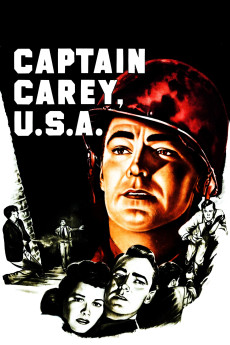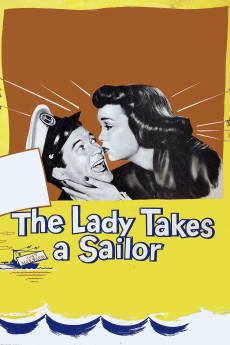Captain Carey, U.S.A. (1949) – Academic and Psychological Review

Plot Summary
Captain Carey, U.S.A. (1949) is a crime drama thriller directed by Mitchell Leisen, starring Alan Ladd as the titular character. The film follows Captain Webster Carey, a former OSS operative, who returns to Italy after World War II to find those responsible for betraying his team. The narrative intertwines elements of mystery and revenge, creating a compelling storyline that keeps viewers on edge.
Characters and Acting
Alan Ladd delivers a strong performance as Captain Carey, portraying a complex character driven by duty and revenge. Wanda Hendrix, as Giulia de Cresci, provides a heartfelt and nuanced performance. Supporting actors such as Francis Lederer and Joseph Calleia add depth to the film with their portrayals of intricate characters. A memorable line from Carey, “You can’t hide from the past forever,” encapsulates the film’s central theme of confronting one’s history.
Direction
Mitchell Leisen’s direction is skillful, balancing the film’s suspenseful and dramatic elements. Leisen effectively uses the post-war Italian setting to enhance the film’s atmosphere. His direction ensures that the narrative remains engaging, particularly through the use of tight pacing and well-executed plot twists. Scenes such as Carey’s investigation in the village showcase Leisen’s ability to build tension and maintain audience interest.
Cinematography
The cinematography by John F. Seitz is a highlight of Captain Carey, U.S.A. The use of chiaroscuro lighting and shadow enhances the film’s noir aesthetic. Seitz’s framing of the picturesque Italian countryside contrasts sharply with the darker elements of the story, creating a visually compelling experience. The climactic chase scenes are particularly well-shot, adding to the film’s overall suspense.
Music and Score
Hugo Friedhofer’s score for Captain Carey, U.S.A. significantly contributes to the film’s emotional depth. The music underscores key moments, enhancing the tension and drama. Friedhofer’s composition complements the film’s themes of loss and retribution, providing an auditory backdrop that heightens the overall impact. The haunting melody during Carey’s return to Italy is especially effective in setting the tone.
Themes
Captain Carey, U.S.A. explores themes of betrayal, revenge, and redemption. The film delves into the psychological effects of war and the difficulty of reconciling one’s past. Carey’s quest for justice serves as a metaphor for the broader struggle of post-war recovery. A key dialogue that reflects this is when Carey says, “In war, the lines are clear. But peace is more complicated.”
Screenplay and Dialogue
The screenplay by Robert Thoeren and Karl Tunberg is well-crafted, balancing action with character development. The dialogue is sharp and reflective of the era, with lines that convey the emotional weight of the characters’ experiences. The script effectively drives the narrative forward while allowing for introspective moments that deepen the audience’s understanding of the characters.
Special Effects
For a film from 1949, Captain Carey, U.S.A. employs impressive special effects, particularly in its action sequences. The practical effects used in the combat and chase scenes are well-executed, adding to the film’s realism. These effects are seamlessly integrated into the narrative, enhancing the overall viewing experience without detracting from the story.
Editing and Pacing
The editing by Alma Macrorie ensures a smooth flow between scenes, maintaining a brisk yet steady pace. The transitions between past and present are handled adeptly, providing clarity and coherence to the narrative. The film’s pacing allows for both action and emotional development, keeping the audience engaged from start to finish.
Production Design
The production design by Hans Dreier and Walter H. Tyler effectively recreates the post-war Italian setting. The attention to detail in the sets, costumes, and props contributes to the film’s authenticity. The use of real locations adds to the immersive quality, making the viewer feel a part of the story’s world.
Historical Accuracy
Captain Carey, U.S.A. offers a reasonably accurate portrayal of post-war Italy and the complexities of the time. While the film takes some creative liberties, the depiction of the societal and political climate is grounded in reality. This historical context enriches the narrative, providing a backdrop that enhances the story’s stakes.
Overall Impressions
Captain Carey, U.S.A. is a gripping crime drama that combines strong performances, expert direction, and a compelling narrative. The film’s exploration of post-war themes and its engaging storyline make it a standout in its genre. It remains a relevant and thought-provoking piece of cinema, showcasing the enduring human struggle for justice and redemption.
Rating and Recommendation
Overall, I would rate Captain Carey, U.S.A. 8.5 out of 10. The film’s strong performances, direction, and thematic depth make it a must-watch for fans of crime dramas and classic cinema. I highly recommend it to those interested in post-war narratives and psychological thrillers. Its blend of suspense and emotional resonance ensures it remains engaging for contemporary audiences.
Cultural Impact
Captain Carey, U.S.A. has had a notable cultural impact, particularly in its depiction of post-war Italy and the psychological aftermath of conflict. The film has influenced subsequent crime dramas and thrillers, setting a precedent for character-driven narratives in the genre. Its exploration of themes such as betrayal and redemption continues to resonate with audiences, reflecting broader societal issues.
Genre Analysis
As a crime drama thriller, Captain Carey, U.S.A. stands out for its focus on psychological depth and character development. Unlike many films in the genre that prioritize action, this film delves into the emotional and moral complexities faced by its characters. This approach adds a layer of sophistication, making it a valuable entry in the genre and an interesting subject for analysis.
Comparative Review
When compared to other films of the era, such as The Third Man (1949) and Out of the Past (1947), Captain Carey, U.S.A. holds its own with its strong narrative and character focus. While it may not have the same level of critical acclaim, it offers a unique take on post-war themes and showcases Alan Ladd’s compelling performance. Its blend of suspense and emotional depth sets it apart from its contemporaries.
Audience Reception
Upon its release, Captain Carey, U.S.A. received positive reviews from audiences and critics alike. Viewers praised the film’s strong performances, particularly by Alan Ladd, and its engaging storyline. The film’s box office success is a testament to its appeal, and it has since gained a following among classic cinema enthusiasts. Its enduring popularity reflects its impact and relevance.
Narrative Structure
The narrative structure of Captain Carey, U.S.A. is linear, following Carey’s return to Italy and his quest for justice. The film uses flashbacks to provide context and background, enhancing the storytelling. This structure allows for a thorough exploration of the characters’ development and the progression of their mission. The film’s pacing and structure effectively balance action with introspection.
Philosophical Analysis
Philosophically, Captain Carey, U.S.A. explores themes of duty, sacrifice, and the burden of past actions. It raises questions about justice and the ethical dilemmas faced by individuals in the aftermath of war. The film’s portrayal of Carey’s internal struggle reflects broader existential questions about responsibility and the human cost of conflict. A key line that encapsulates this philosophical depth is Carey’s reflection, “Justice isn’t always clear-cut.”
Technical Analysis
From a technical standpoint, Captain Carey, U.S.A. excels in its use of sound design and lighting. The sound effects during tense moments are realistic and immersive, adding to the film’s intensity. The lighting is used effectively to create mood and atmosphere, particularly in scenes depicting the psychological strain on the characters. These technical elements enhance the film’s overall impact.
Subtext and Interpretation
On a deeper level, Captain Carey, U.S.A. can be interpreted as a commentary on the psychological impact of war and the isolation it brings. The film’s depiction of Carey’s journey reflects broader themes of resilience and the human capacity to endure hardship. The subtextual elements add layers of meaning to the film, making it a rich subject for analysis. It invites viewers to consider the deeper implications of war and the personal cost of seeking justice.
Director’s Previous Work
Mitchell Leisen, the director of Captain Carey, U.S.A., was known for his work in various genres, including drama and comedy. His previous films, such as Hold Back the Dawn (1941) and To Each His Own (1946), showcased his ability to handle complex narratives and character-driven stories. Captain Carey, U.S.A. is a testament to Leisen’s versatility and skill as a director, blending suspense with deep character studies.
Literary Adaptation
Captain Carey, U.S.A. is based on the novel “No Surrender” by Martha Albrand. The film adaptation stays true to the source material, capturing the essence of the book’s themes and character dynamics. The screenplay effectively translates the novel’s exploration of revenge and psychological stress to the screen, making it a successful adaptation. The film’s fidelity to the source material enhances its narrative depth.
Full Academic Review
Captain Carey, U.S.A. is a film that warrants thorough academic scrutiny due to its intricate depiction of post-war trauma and the psychological burdens of seeking justice. The narrative, set in the aftermath of World War II, follows Captain Webster Carey as he returns to Italy to find those responsible for betraying his team. The film explores the moral complexities of revenge and the psychological toll of war. Notable dialogue such as Carey’s assertion, “You can’t run from the shadows of your past,” encapsulates the film’s poignant commentary on the nature of justice and resilience under extreme pressure. From an academic perspective, the film is rich with themes related to military ethics, psychological resilience, and the post-war recovery, making it a valuable resource for scholarly analysis.
Full Psychological Review
The psychological dimensions of Captain Carey, U.S.A. are central to its narrative. The film delves into the mental strain experienced by war veterans and the complexities of post-war adjustment. Captain Carey’s transformation from a hardened operative to a man seeking closure underscores the film’s exploration of psychological healing. The stress, anxiety, and moral dilemmas faced by the characters are portrayed with remarkable depth, offering insights into the psychological impacts of conflict. A significant line that reflects this psychological exploration is when Carey confides, “You can’t bury the past; it always finds a way back.” This makes Captain Carey, U.S.A. a significant film for psychological analysis, particularly in understanding the mental health challenges faced by war veterans.
Historical Analysis
Captain Carey, U.S.A. provides a historically accurate portrayal of post-war Italy and the OSS operations during World War II. The film’s depiction of military strategies, the political climate, and the daily life in post-war Europe is well-researched and authentic. This attention to detail makes the film a valuable resource for understanding the historical context and realities of post-war recovery.
Cultural Studies
From a cultural studies perspective, Captain Carey, U.S.A. reflects the societal attitudes and values of its time. The film’s portrayal of post-war struggles, the quest for justice, and the impact of betrayal resonate with the cultural ethos of the late 1940s. It also offers insights into the ways in which films of the period shaped public perceptions of war and its aftermath. The cultural impact of the film extends to its influence on subsequent crime dramas and its role in depicting post-war realities.
Film Theory
Applying film theory to Captain Carey, U.S.A. reveals its sophisticated use of cinematic techniques to convey psychological and emotional depth. The film’s narrative structure, character development, and visual style can be analyzed through various theoretical frameworks, including psychoanalytic theory and auteur theory. Mitchell Leisen’s directorial choices and Alan Ladd’s performance contribute to the film’s status as a classic, offering rich material for theoretical analysis.
Critics’ Reviews
Upon its release, Captain Carey, U.S.A. received critical acclaim for its realistic portrayal of post-war experiences and strong performances. Critics praised the film’s depth, direction, and the authenticity of its depiction of military life. The film’s enduring popularity and continued critical recognition underscore its significance in the crime drama genre.
Genre-Specific Reviews
As a crime drama, Captain Carey, U.S.A. stands out for its focus on the psychological aspects of post-war trauma and the quest for justice. This sets it apart from other crime dramas that primarily emphasize action and suspense. The film’s nuanced exploration of the mental and emotional challenges faced by its characters makes it a unique and valuable contribution to the genre.
Festival Reviews
Captain Carey, U.S.A. has been showcased at various film festivals, where it has been lauded for its historical accuracy and powerful performances. The film’s festival screenings have contributed to its recognition as a classic, highlighting its impact and relevance in cinematic history.
Download Subtitles
For those interested in viewing the film with subtitles, you can download the subtitle file from the following link: Download Subtitles







